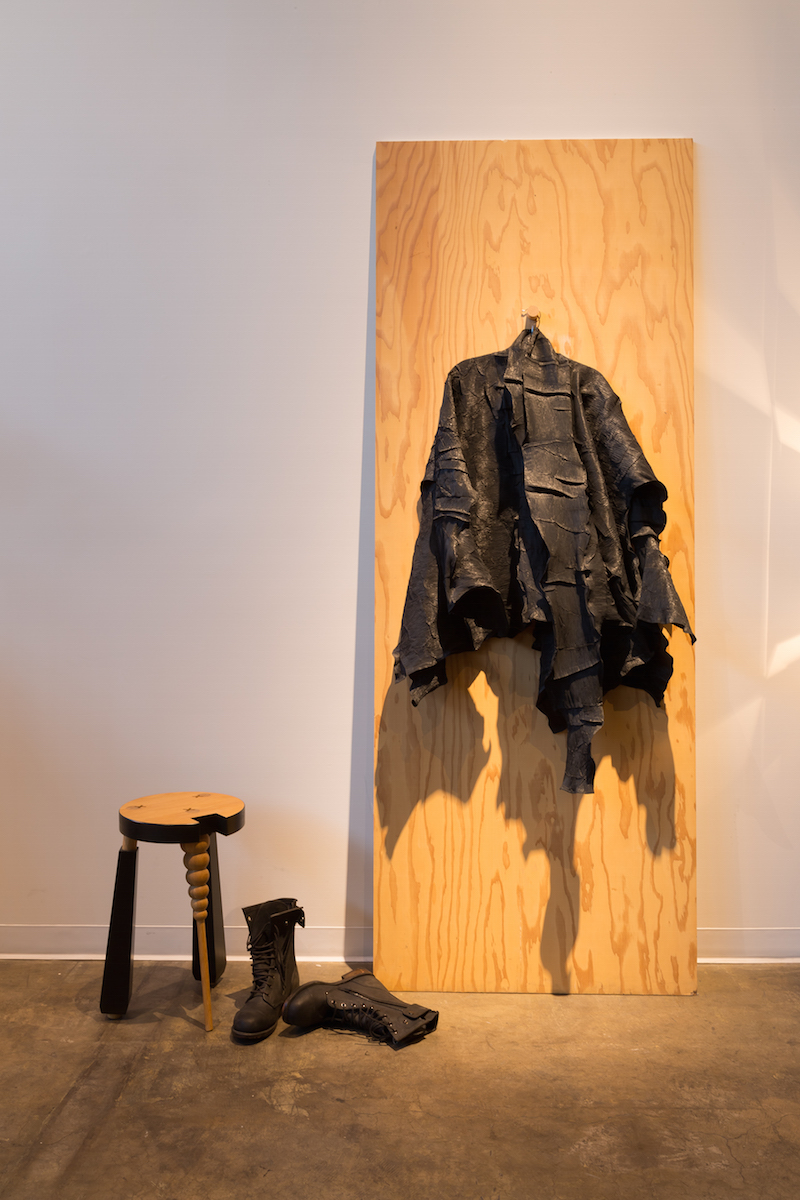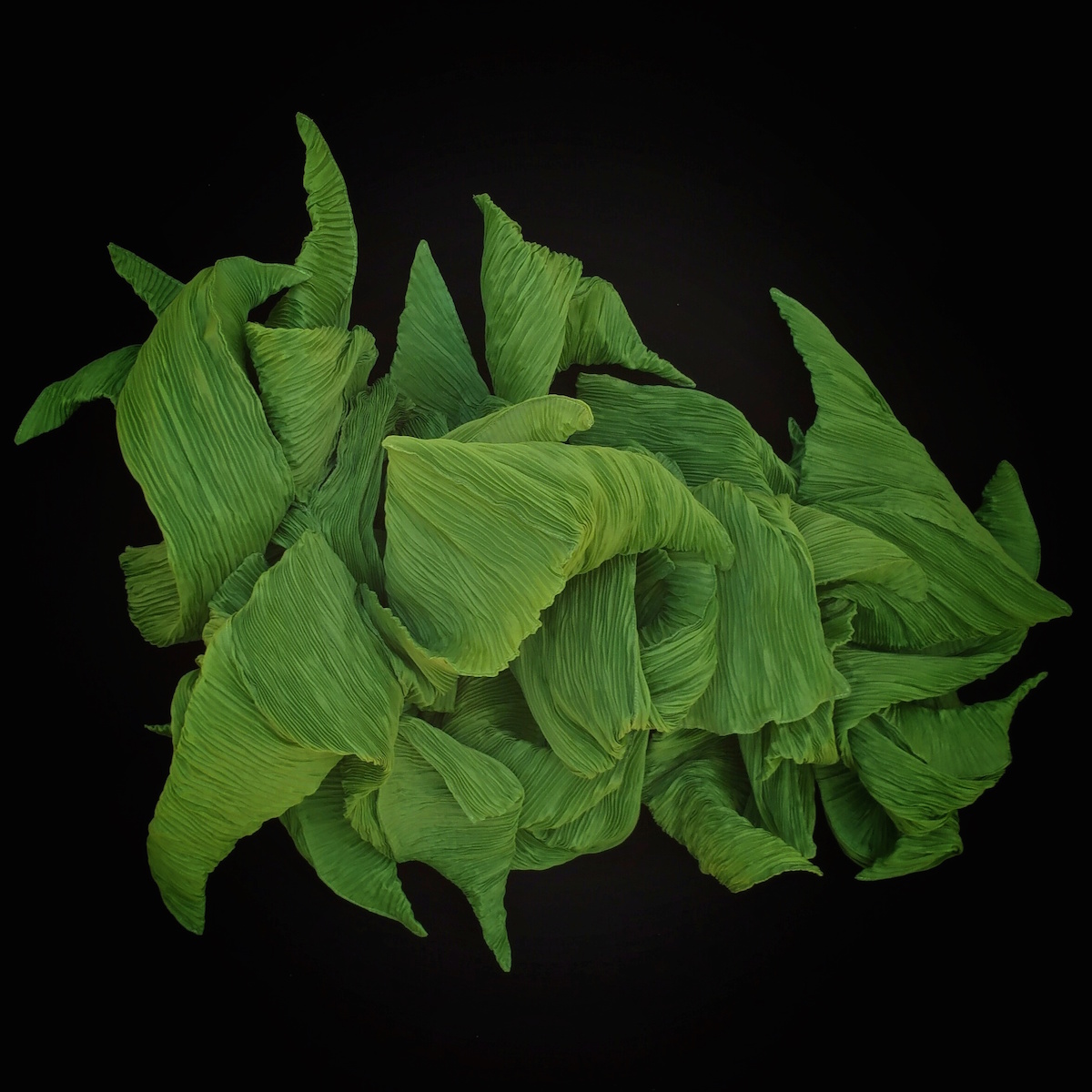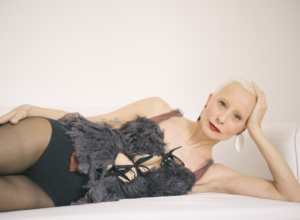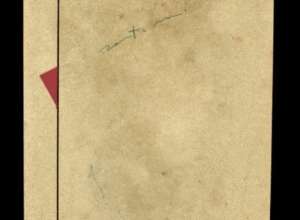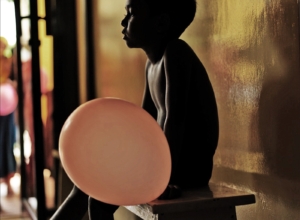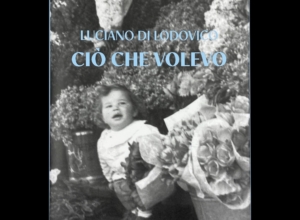Prendere il tessuto tra le mani e tagliarlo, manipolarlo, cucirlo. Estrarre da esso le singole componenti di un indumento e poi assemblarle come fossero tanti pezzi di un’unica scultura. Mattoni di una casa in costruzione.
“Mi sono sempre chiesta cosa potessi creare partendo da un pezzo di tessuto di forma regolare. Come poter lavorare i materiali fino a conferirgli un determinato volume e come dare vita a capi confortevoli da indossare e capaci di garantire ampia libertà nei movimenti. Una casa per il corpo, questo l’obiettivo a cui tende tutto il mio lavoro. Perché andare oltre i confini significa per me andare oltre l’apparenza delle cose e creare, senza regole e senza limiti.”
L’amore per i tessuti che anima tutto il poliedrico lavoro di Elke Walter nasce un giorno davanti a un minuscolo negozio di Montpelier. Lo sguardo sui broccati di seta e quasi si ferma il respiro. Da subito il desiderio di farne qualcosa, di indossarle quelle stoffe andando alla ricerca della propria identità, della propria autenticità, percorrendo in maniera anche ostinata l’unica via possible: la propria.
“La prima cosa che ho realizzato è stata una copia del mio vestito preferito, ma, concluso il lavoro, non ero per niente soddisfatta. Era come se il vestito non avesse la mia voce. Così ho deciso di affidarmi al mio istinto e far emergere il mio stile, in modo divertente e anche rudimentale, tagliando il tessuto davanti allo specchio, fissandolo e poi cucendolo a macchina.”
Nata e cresciuta in un piccolo paese nel nord della Germania, studia ad Amburgo, vive per un certo periodo nel sud della Francia e fa poi ritorno con il marito e i tre figli ad Amburgo dove lavora principalmente nel mondo della pubblicità come copywriter.
“Nel luogo in cui sono nata mi sono sempre sentita e probabilmente comportata come un alieno. Mia mamma voleva che io facessi l’insegnante, che calcassi le sue orme insomma, e per un certo periodo ho anche cercato di assecondare i suoi sogni iscrivendomi all’Università ad Amburgo. Ma dentro sempre quella sensazione di essere un alieno per cui ho mollato gli studi dopo poco.”
La sua attività di designer inizia nel 2002, con l’aiuto di una cara amica e stilista di gioielli, Hilde Leiss, proprietaria della galleria d’arte che per prima ad Amburgo supporta il suo lavoro. Segue l’apertura del primo negozio e una attività frenetica che spazia dalla creazione alla vendita e la impegna senza sosta giorno e notte. I riferimenti estetici sono quelli dei maestri giapponesi, alcune sperimentazioni che arrivano dalla Corea e dalla Spagna, ma la principale fonte di ispirazione rimane sempre e comunque il tessuto con tutte le sue possibilità e impossibilità. Come in preda all’urgenza di far emergere la tensione creativa che abita dentro e che induce a realizzare pezzi sempre unici e originali.
“Devo confessare che ho sempre e solo seguito il mio gusto, se poi quello che faccio a qualcuno non piace…pazienza. A volte consumo anche dieci o quindici metri di tessuto per realizzare un vestito o un cappotto, ma non mi interessa nella stessa misura in cui non mi è mai interessato entrare a far parte dell’industria della moda. Ci sono stati nel tempo investitori che mi hanno proposto di produrre su larga scala ma non fa per me, non è la strada che voglio intraprendere io.”
Il nero eloquente dei suoi abiti in forma di scultura catturano l’attenzione di Nasir Kassamali, proprietario di un importante negozio di design di Miami, che le propone di sfilare con le sue creazioni in occasione della fiera internazionale di arte moderna e contemporanea Art Basel. E’ lì che avviene un incontro determinante per la carriera ma anche per la vita di Elke, quello con l’architetto e designer irachena Zaha Hadid.
“Lei amava il mio stile eccentrico e io adoravo lavorare per lei al punto che con il tempo, acquistando un capo dopo l’altro, ha finito per possederli quasi tutti. Il suo desiderio di indossare qualcosa al di fuori dell’ordinario è stato sempre uno stimolo per me per continuare a creare. Di lei ammiravo l’indipendenza, lo stile, la forza. E ora mi manca, se ne è andata via troppo presto. Ma ancora adesso, quando lavoro a un progetto mi capita spesso di chiedermi: cosa avrebbe pensato Zaha? Le sarebbe piaciuto?”
L’inventiva si spinge oltre i confini, oltre il territorio rassicurante del noto e del conosciuto, lì fin dove l’assenza degli schematismi della moda permette di arrivare e permette al tessuto di esprimersi in forme inattese, non solo quelle degli abiti ma anche quelle delle sculture e dei gioielli. Dal canto suo pure la natura, specie quella suggestiva del sud della Francia, diventa a sua volta territorio atto a sondare le potenzialità dell’immagine fotografica.
“E quando le persone dicono di me che ho l’occhio del fotografo mi sento incoraggiata ad andare a avanti, a superare i limiti ancora una volta. L’importante è che rimanga una fotografia spontanea ed è il mio smart phone che mi dà questa libertà. Non lo cambierei mai con una macchina fotografica! Almeno credo…chissà.”
Una sperimentazione che si nutre degli stimoli più disparati, quelli che arrivano dalla moda, dall’arte ma anche dal design e dall’architettura e che si mostra in tutta la sua esaltazione perché guidata dalle sole regole dell’audacia e del nuovo. In un tempo che vuole essere senza tempo. Durevole, al pari del pensiero che lo anima.
Desidero ringraziare per la cortese intervista Elke Walter – web site – Facebook – Instagram
ELKE WALTER, PUSHING THE BOUNDARIES (English text)
D: Dear Elke, tell me something about you: who is Elke? First of all I’d like to know about your family, your education, your interests…
E: I was born and raised in a small town in Northwest Germany, a place where I always felt – and probably behaved – like an alien. My mother wanted me to be a teacher like her, and for a while I did my very best to fulfill her dreams and started studying in Hamburg. But there was this same old alien feeling again when I did my first internships at schools. So I gave up University, sold fancy clothes in boutiques for a while and finally got stuck in advertising as a copywriter. I met my husband, our 3 sons were born and we both started writing short stories – the kind that’s called ‘true stories’ – for some German women’s magazines. Later we all moved to the South of France and stayed there for 7 years before going back to Hamburg. I started my own business there in 2002, with the help of my very good friend Hilde Leiss, a fantastic jewelry designer and gallery owner in Hamburg, who was the first to sell my designs. I opened my own store the same year, creating and sewing mornings and evenings and selling in the afternoon. And yes – it was good, from the beginning on. If you want to know who Elke is, you should probably ask someone else. I’m still trying to find out…
D: When did you become familiar with fabrics? And why?
E: While living in Montpellier I discovered a tiny store that sold silk brocades from Lyon. I could hardly breathe, so much did I like those fabrics. And I absolutely wanted to wear them. My first work was a copy of my favorite dress, and when I finished I was unhappy: The dress didn’t have my own “voice”. So I decided to invent a style, in a very very funny and rudimentary way, cutting into the fabric in front of the mirror, pinning my work and then sewing it on an old Pfaff machine. I refused any advice or help. Finally I found something, where I could teach myself. Learning by doing, day after day, I’d never been so diligent. That was the moment when I didn’t have to accept what others had done before – I made my own style instead. I am stubborn enough to be and stay 100% selftaught!
D: Always pushing the boundaries, you create unique sculptures. Can you describe your creative process?
E: The goal in all of my work was from the beginning on: What can I create out of a rectangular piece of fabric? How can I manipulate it by cutting, folding and sewing to become a piece with a certain volume? And, also, how can I achieve free movement and comfort for the one who wears my dress? Pushing the boundaries means for me trying to get beyond the things, creating without rules or limits. It’s my own dogma for example to cut garments out of one peace of cloth and then building it up like a house – or a sculpture. A home for your body. Sometimes I need 10 or 15 meters of fabrics for a dress or coat – I don’t mind. As I was never interested to be part of the fashion industry, I felt free to do what I want. There were investors who wanted to convince me to do big-scale business, but that didn’t attract me at all. I did collections and for a while, had some very successful line called ESSENTIALS, all made from black microfiber crêpe, but it became boring for me and I stopped it last year. At least I know what I do not want…
D: How did you get in touch with the ‘Queen of the curve’, the very famous Iraqi-British architect Zaha Hadid? How did she influence your work?
E: Nasir Kassamali from Miami’s Luminaire design stores discovered me on a fair in New York, and he liked the simple black clothes, my Tokyo Line, I was selling there. He proposed an Elke Walter show in his store during Design Miami/Art Basel. Instead of showing the black line I arrived with 13 one of a kind pieces, and they went on show. I did not sell one single piece, but I met Zaha, and she loved my intergalactic style. She wanted them for free, but I refused and went home with no sales. Later she bought one after the other, she bought almost all of them. She became one of my best clients and as she liked my most extravagant pieces, I loved working for her. Her wish to wear something extraordinary pushed me to create it. I admire her independence, her style, her strength. I miss her. She’s gone too early. But still, when I’m working on something, it happens to me very often that I ask myself: what would Zaha think about it? Would she like it?
D: What about your fashion research? Where do you get your aesthetic inspiration from? How would you describe “One of a kind” line?
E: Before I started creating by myself, I was very busy with raising children. I read some magazines and my favorite was GAP with all the collections from worldwide fashion shows. I liked Japanese, Korean and Spanish Designers at that time. But what I liked was much too expensive for me. I was never able to afford one of these pieces. But I guess I was training my eye without knowing it. Later, when I started to make garments, I found out that fabric is my inspiration. Fabric with all its possibilities and impossibilities. And I admit, I always followed my own taste. If someone else didn’t like it…so what? Many years later I was inventing lines, but the bigger challenge always was to create something that hadn’t been created before – the one-of-a-kind. It always feels as if something deep inside wants to get out. Giving birth to a new creation – not such a bad feeling.
D: Art seems to be the “fil rouge” of your life, as a matter of fact you are a photographer and a jewels designer too. Can you describe the connection between the different fields you are working in?
E: It is not only art that is important to me, it is design, architecture, the bold creation, something new but enduring. I love art and design much more than fashion, I feel much closer to architects and designers. They do what I do: create something that lasts for a very long time, not just for one or – if you’re lucky – for some more seasons.
I started photography after moving back to the South of France. Here I’m living surrounded by the most wonderful nature I can imagine. As I love it so much I started to take pictures. First nature, then fabrics and now mainly my own work, fabric sculptures and jewelry. And when people reassured me that I got ‘the eye of a photographer’ I felt encouraged to go further, make more – pushing the boundaries once again. Important for me is that my photography is spontaneous – and it’s my smart phone that’s offering me this freedom. I would never change it against a camera. No, never. In fact, who knows…The jewelry I’m creating is made from fabric, as well as sculptures and objects, offering me the possibility to go further, beyond the limits of dresses that have to be wearable. More freedom, even more pleasure.





